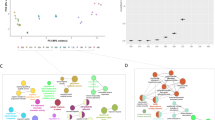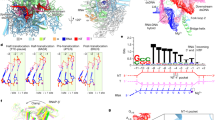Abstract
In bacteriophage T4 DNA, transcription units recognized in vitro by host RNA polymerase consist of promotor-proximal ‘immediate early ’ (IE) genes and promotor-distal ‘delayed early ’ (DE) genes separated from each other by ρ-dependent transcription terminators1. In vivo, the transition from IE to DE transcription requires phage-specific protein synthesis and can be prevented by chloramphenicol (CAM)2. Most of the information about IE/DE transition has been obtained by hybridization analyses of mixtures of RNA species synthesized simultaneously on several T4 transcription units (for review see ref. 3). A useful model for the study of T4 gene expression at the level of primary transcripts and individual gene products is provided by the T4 tRNA operon, a cluster of genes coding for eight T4-specific transfer RNAs and two stable RNAs (species 1 and 2) of unknown function (Fig. 1). The 10 genes of the tRNA operon are arranged in two subclusters (I and II) with a promotor located about 1 kilobase pair upstream4,5. The primary transcripts and the final gene products of this region have been identified and isolated6,7. Moreover, this genetic region was recently cloned and a part of it sequenced5,8. We describe here the expression of T4 tRNA genes in vivo and in vitro in terms of the IE/DE concept and demonstrate that the two subclusters of the tRNA operon are subject to different modes of control.
This is a preview of subscription content, access via your institution
Access options
Subscribe to this journal
Receive 51 print issues and online access
$199.00 per year
only $3.90 per issue
Buy this article
- Purchase on SpringerLink
- Instant access to full article PDF
Prices may be subject to local taxes which are calculated during checkout
Similar content being viewed by others
References
O'Farrell, P. Z. & Gold, L. M. J. biol Chem. 248, 5512–5519 (1973).
Salzer, W., Bolle, A. & Epstein, R. J. molec. Biol. 49, 271–296 (1970).
Rabussay, D. & Geiduschek, E. P. in Comprehensive Virology Vol. 8, (eds Fraenkel-Conrat, H. & Wagner, R.) (Plenum, New York, 1976).
Fukada, K., Ostuka, A. & Abelson, J. J. molec. Biol. 137, 191–211 (1980).
Fukada, K., Gossens, L. & Abelson, J. J. molec. Biol. 137, 213–234 (1980).
Goldfarb, A., Seaman, E. & Daniel, V. Nature 273, 562–564 (1978).
Goldfarb, A. & Daniel, V. in preparation
Fukada, K. & Abelson, J. J. molec. Biol. (in the press).
Nierlich, D. P., Lamfrom, H., Sarabhai, A. & Abelson, J. Proc. natn. Acad. Sci. U.S.A. 70, 179–182 (1973).
Wilson, J. H. & Abelson, J. J. molec. Biol. 69, 57–73 (1972).
McClain, W. H., Guthrie, C. & Barrell, B. G. J. molec. Biol. 81, 157–171 (1973).
Adhya, A. & Gottesman, M. A. Rev. Biochem. 47, 967–996 (1978).
Wilson, J. M., Kim, J. S. & Abelson, J. J. molec. Biol. 71, 547–556 (1972).
Roberts, J. W. Nature 244, 1168–1174 (1969).
Author information
Authors and Affiliations
Rights and permissions
About this article
Cite this article
Goldfarb, A., Daniel, V. Transcriptional control of two gene subclusters in the tRNA operon of bacteriophage T4. Nature 286, 418–420 (1980). https://doi.org/10.1038/286418a0
Received:
Accepted:
Issue date:
DOI: https://doi.org/10.1038/286418a0
This article is cited by
-
Molecular evolution of bacteriophages: Discrete patterns of codon usage in T4 genes are related to the time of gene expression
Journal of Molecular Evolution (1991)
-
Dual function transcripts specifying tRNA and mRNA
Nature (1981)



